Red birds of the world impress with their vivid coloring. Red plumage comes in different nuances on birds.
From bright red to dark red, there are many specific nuances such as crimson or carmine which make distinct red species.
Some of the most common birds in The United States are also red. Specie such as The Northern Cardinal is known for spreading as people install bird feeders away from their typical range.
Other types of red birds include flamingos and parrots. Many of these are found in coastal areas, mudflats, and the tropical forests of the world.
Red birds may only be red during the breeding season, as a male trait to attract females.
They may also be partly red, which is the case with most species.
Red plumage on birds may also be a result of their diets, mostly carotenoids.
The following species of red birds are highly abundant in their range with many spreading across multiple countries and continents.
Table of Contents
1. Northern Cardinal
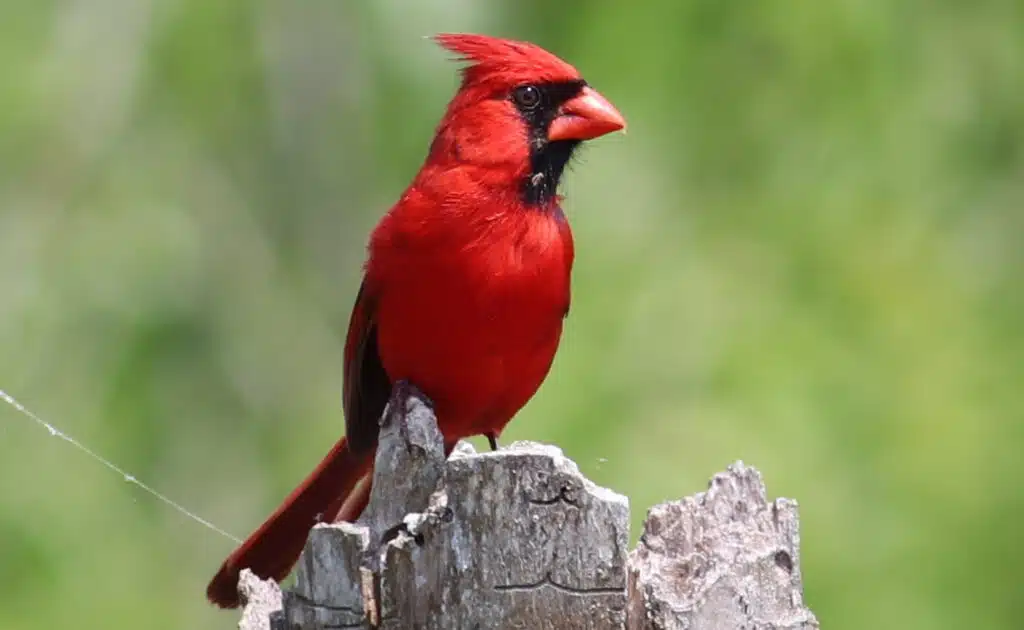
One of the most common red birds in North America, The Northern Cardinal (Cardinalis cardinalis) is also one of the most common species of birds in Eastern North America, in general.
This is a species that showcases red plumage across its body as a result of its diet.
Bids of this species metabolize carotenoids from their diets to become either red or yellow. Its red morph tends to be dominating.
This is a morph in which the head, back, wings, and underbelly of the species are mostly red.
The black face of the species looks similar to a mask.
Commonly spotted in pairs, these birds also have peculiar breeding habits. For example, males can feed seeds to females to impress them.
The common nature of Northern Cardinals makes it a state bird in multiple East US states.
This species is growing in populations, slowly expanding its reach towards Northern territories.
The presence of seeds in the Northern territories helps the species move across Eastern US, up to the Southeastern parts of Canada.
Distribution – Eastern and Southern United States, Eastern Central America
Red plumage nuance – bright red
2. Vermilion Flycatcher
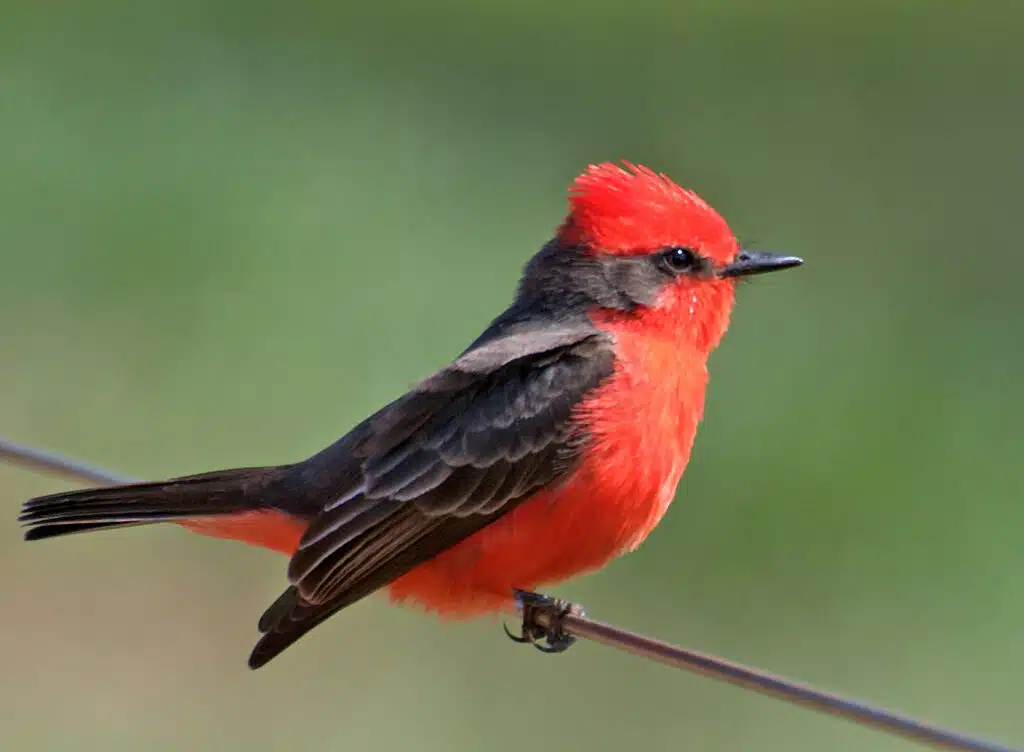
The Vermilion Flycatcher (Pyrocephalus rubinus) is a common red bird species named after its vivid red color.
This red color nuance is known as vermilion and it used to be a color used in old artwork. This red nuance is the red nuance of cinnabar.
Birds of this species are dominated by vermilion-red coloring on the head, chest, and belly while their wings are black.
Much of their range includes riparian areas or areas with plenty of vegetation around water.
They are present in The United States, but mostly along the Mexico border.
Vermilion Flycatchers may also be known under different names. The red nuance of the head has inspired the name of Fire Head for the species.
Distribution – Southern United States, Central America, Northern South America
Red plumage nuance – vermilion red
3. Summer Tanager
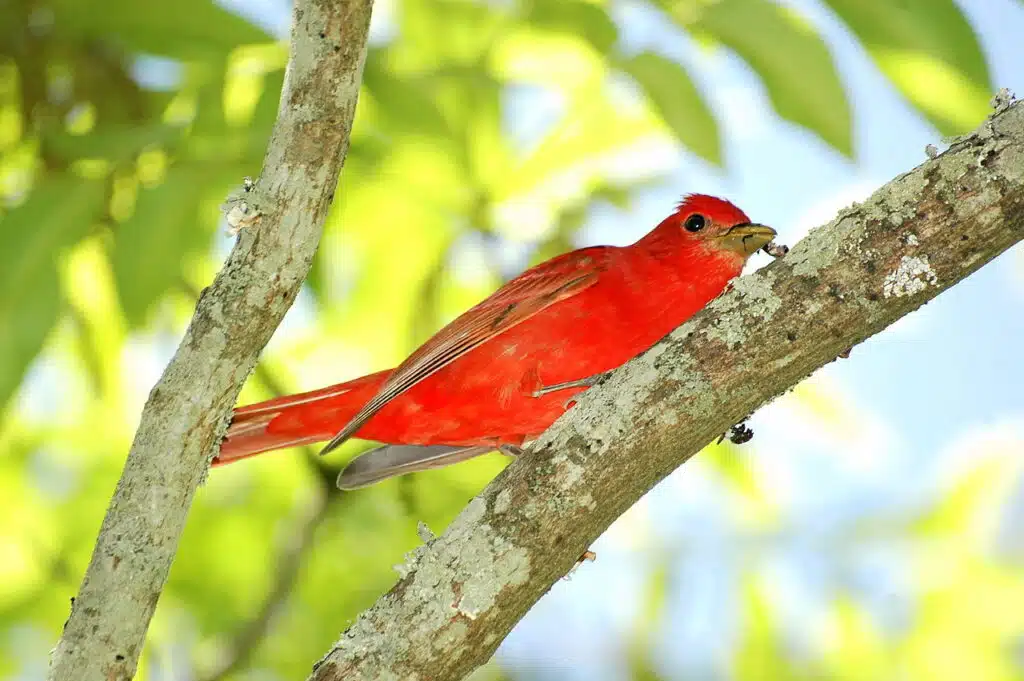
Summer Tanagers (Piranga rubra) are another common sight in parts of North America. The species might also be referred to as The Summer Red, a summarization of its seasonality and appearance.
Numerous red nuances are specific to Summer Tanagers.
These birds have bright red and dark red plumage and feathers, depending on the areas of their bodies.
Darker red nuances are specific to the wings while the head and belly are mostly bright red.
While impressive in its red nuance, it’s only the males of this species that are red as females are yellow.
Colorful birds of this species may be seen around oaks of the South.
Distribution – Southern and Southeastern United States, Central America, Northern South America
Red plumage nuance – pale red, vivid red
4. Scarlet Tanager
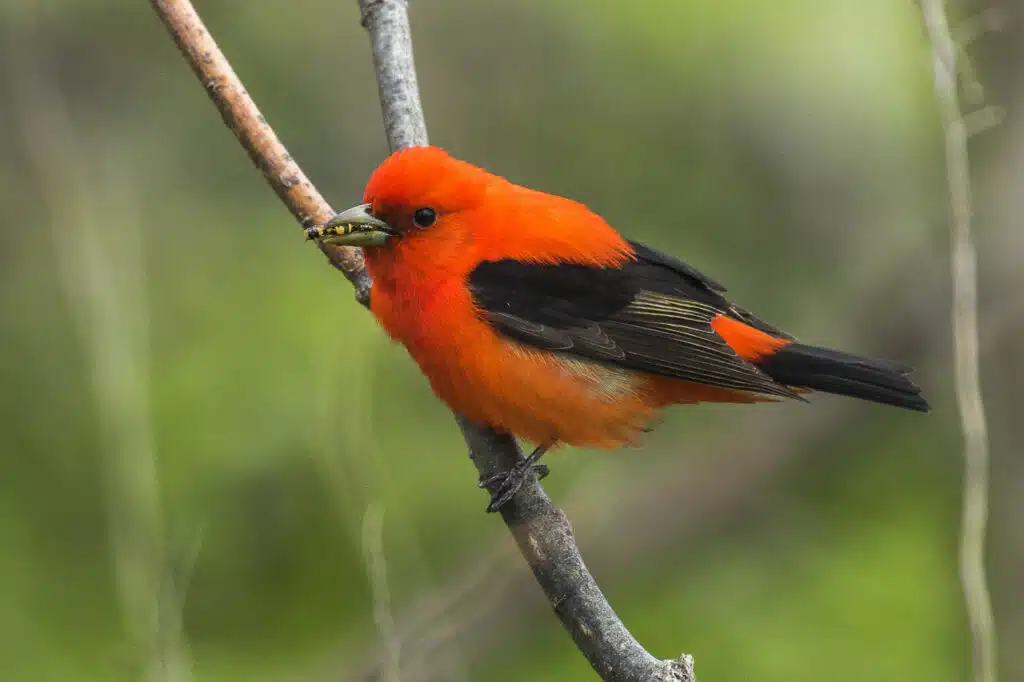
Scarlet Tanagers (Piranga olivacea) are marked by a contrasting appearance. Only the males of this species are red, but only in certain conditions and to a certain extent.
Male Scarlet Tangers are red going into the breeding season.
They show a vivid red head and underbelly while their wings are black. In some cases, male Scarlet Tanagers also have orange plumage.
In this situation, the orange plumage is mostly visible on the upper back and partly visible on the red underbelly.
Females of this species have an olive color with faint red spots on the underbelly.
Distribution – Eastern North America, East Mexico, Ecuador, Colombia, Peru
Red plumage nuance – vivid red
5. House Finch
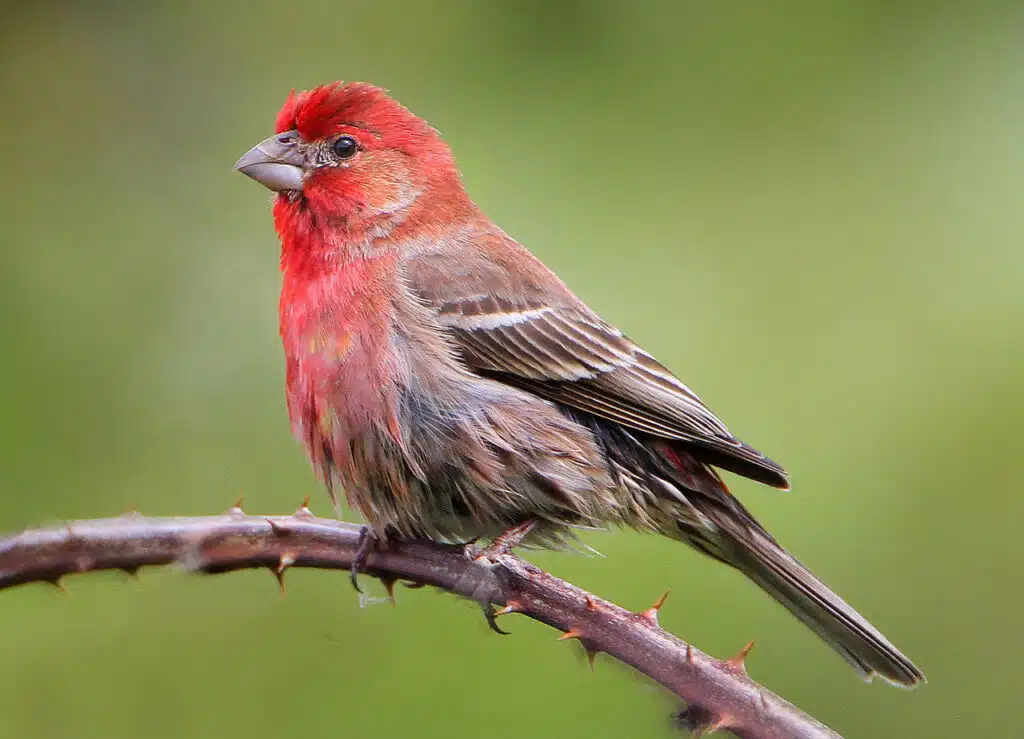
One of the most common urban birds of North America, House Finches (Haemorhous mexicanus) is also characterized by a tendency to show vivid red coloring.
Males of this species are differentiated from females by their red plumage.
Most males have a red head and additional red plumage on the upper chest. In some cases, males may also have red plumage on the lower belly.
Females have a streaked appearance without any red nuances.
A species found throughout the cities of The United States, House Finches may also be a migratory species.
Populations in cooler Northern cities are known to move South for the winter.
Distribution – Southern Canada, United States, Mexico
Red plumage nuance – vivid red
6. Cinnamon Teal
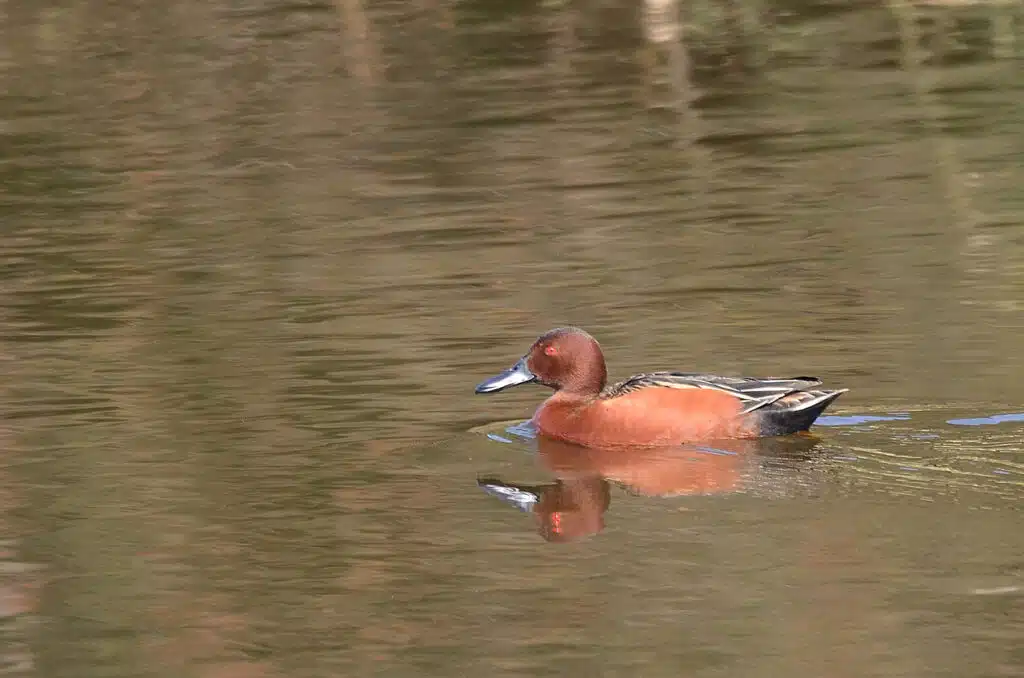
Cinnamon Teal ducks (Spatula cyanoptera) are marked by a very specific red nuance. Cinnamon-red is the color specific to the males of the species.
Their heads and necks have a brighter red nuance while the rest of the plumage is darker cinnamon-red.
Females of the species are dull-colored and may look like a completely different species.
A common sight around Western US ponds and lakes, Cinnamon Teals are also seen in the areas they migrate towards.
These areas are vast and expand to The Caribbean and further South to South America.
California and Arizona are often pit-stops for these birds in the overwintering migration.
Distribution – Western and Southwestern United States, Central America, Western South America
Red plumage nuance – red, brown red
7. Purple Finch
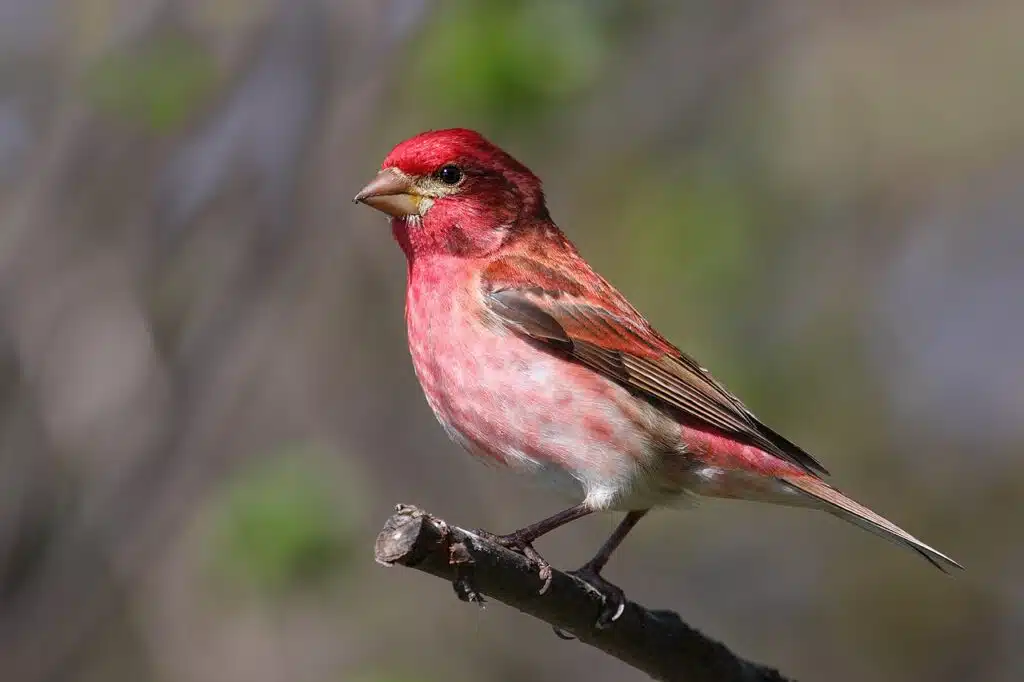
Clear coloring differences between male and female Purple Finches (Haemorhous purpureus) are seen every breeding season.
While the female is streaked and dull-colored, males take on a vivid red nuance, particularly on their heads and necks.
The head of the male has dark red and bright red colors, together with the chest. The lower underbelly has a brighter red nuance while its wings are dark, almost black, with a few faint red undertones.
The red nuances of males attract females in the breeding season. The red nuances of the species have a pink nuance to them, often being compared to the color of raspberries.
Birds of this species eat seeds and are known for their rapid flight with quick direction changes.
Distribution – Canada, Eastern United States, Western United States, Central America, Cuba
Red plumage nuance – raspberry-red
8. Pine Grosbeak
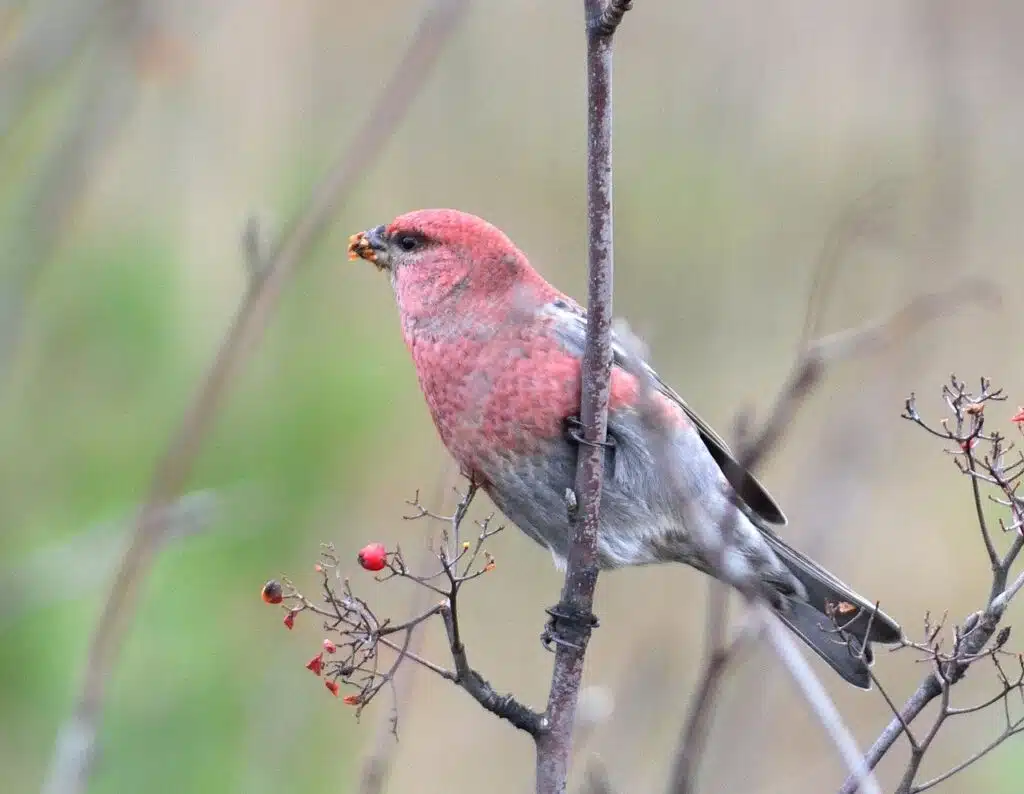
This type of bird (Pinicola enucleator) moves with its food supply and is known for having males with red plumage.
Pink-red and rust-red nuances are mostly specific to the male Pine Grosbeak.
Females are mostly gray, only sharing black wing coloring with males.
While abundant in sub-Arctic regions, these birds may be completely gone from an area in certain years.
As a species that only eats fruits in the winter, Pine Grosbeaks easily navigate regions for food during the cold months.
Some of the best areas to spot these birds include regions of North America with numerous fruit crops. However, Pine Grosbeaks are mostly seen in Canada as they only migrate to The United States.
Distribution – Canada, Alaska, Northern United States, Scandinavia, Siberia
Red plumage nuance – rose-red, rust-red
9. Hepatic Tanager
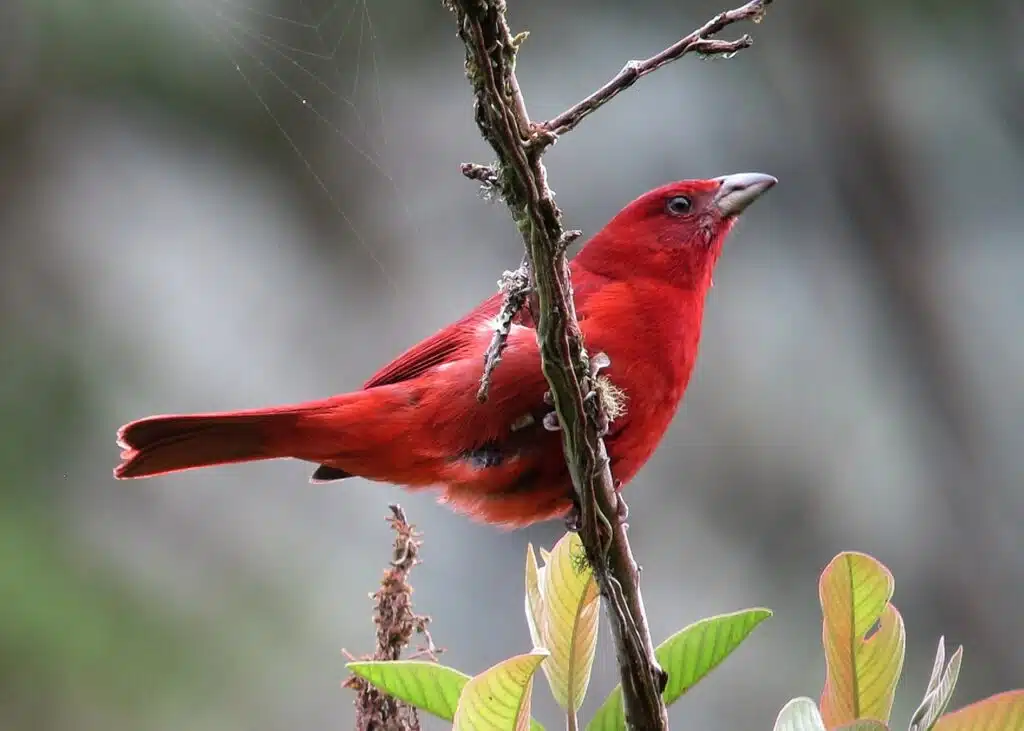
A bright red color is specific to almost all body parts of the male Hepatic Tanager (Piranga flava).
The vivid red coloring is specific to its head and underbelly. A similar color is seen on its shoulders while its wings are black and red.
Females have a yellow-olive color which is also almost uniform and never show red plumage.
Hepatic Tanagers are a sporadic sight in North America as they are most dominant in Central America.
Still, they can be seen in Arizona and in small remote populations across the Southern parts of California.
Some of the populations of Hepatic Tanagers in Central America are known to migrate but most populations across The Americas are resident.
Distribution – Arizona, New Mexico, California, Central America, South America
Red plumage nuance – bright red
10. White-winged Crossbill
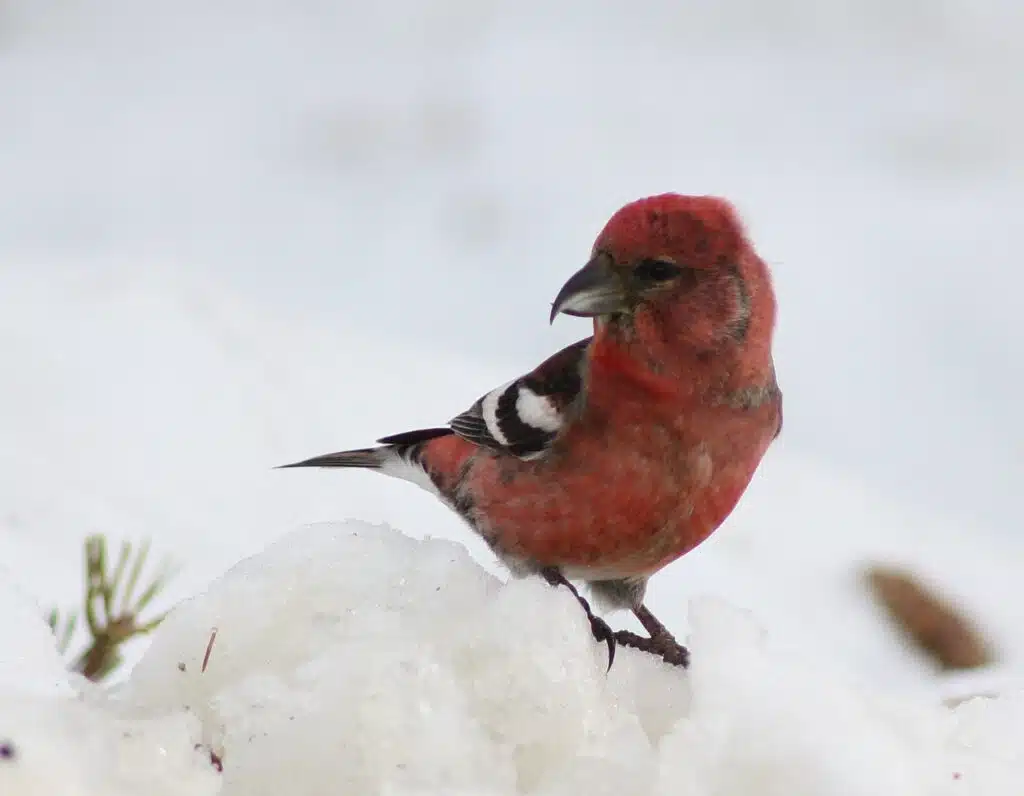
There are a few main reasons why The White-winged Crossbill (Loxia leucoptera) stands out among other birds.
A crossed bill is one of them, as its name suggests.
Red plumage is another main trait that makes these birds stand out. A red head and a red chest are characteristic of the males of this species.
Its back is also red, of a similar pale nuance as the rest of its red plumage. Females have a multicolored olive, yellow, and black appearance.
While also cross-billed as an adaptation to feeding on cones, females don’t show red plumage even going into the breeding season.
Distribution – Northern United States, Canada, Alaska, Northern Europe
Red plumage nuance – pale red
11. Red Phalarope
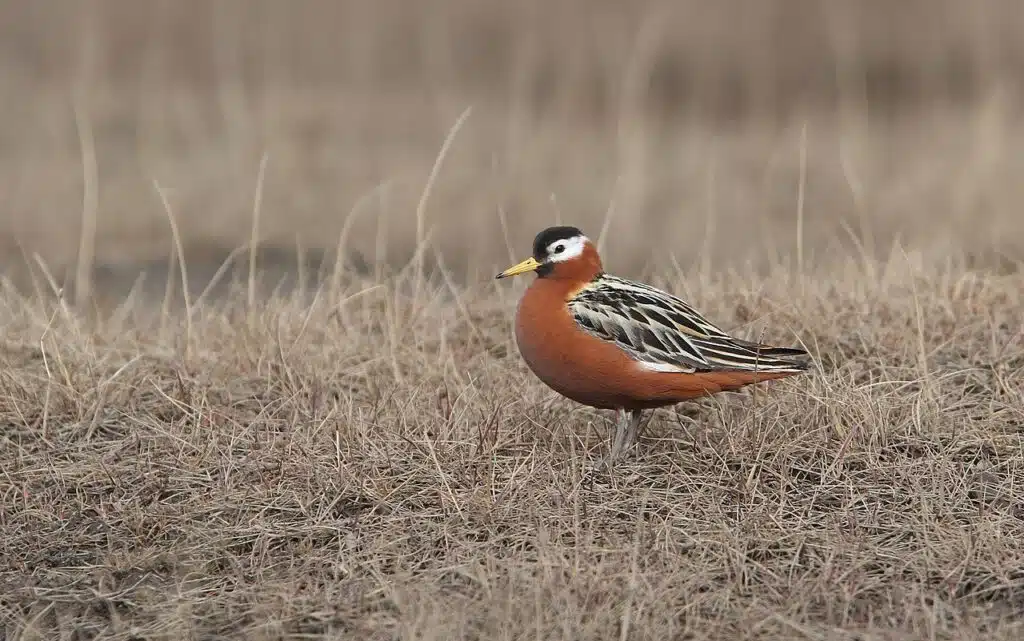
Red Phalaropes (Phalaropus fulicarius) are a common species that turns red during the breeding season. Typically white and gray, this species shows discolored red nuances as it breeds.
Males of this species turn red from having a white underbelly. The red nuance is often compared to rotten tomato nuances.
Its crown also turns black, from a more typical white and gray appearance.
Female Red Phalaropes show a combination of tan, black, and white colors. However, females also change their appearance going into the breeding season.
Distribution – United States, coastal areas of Canada, Greenland, Iceland, Europe
Red plumage nuance – red-brown
12. ʻApapane
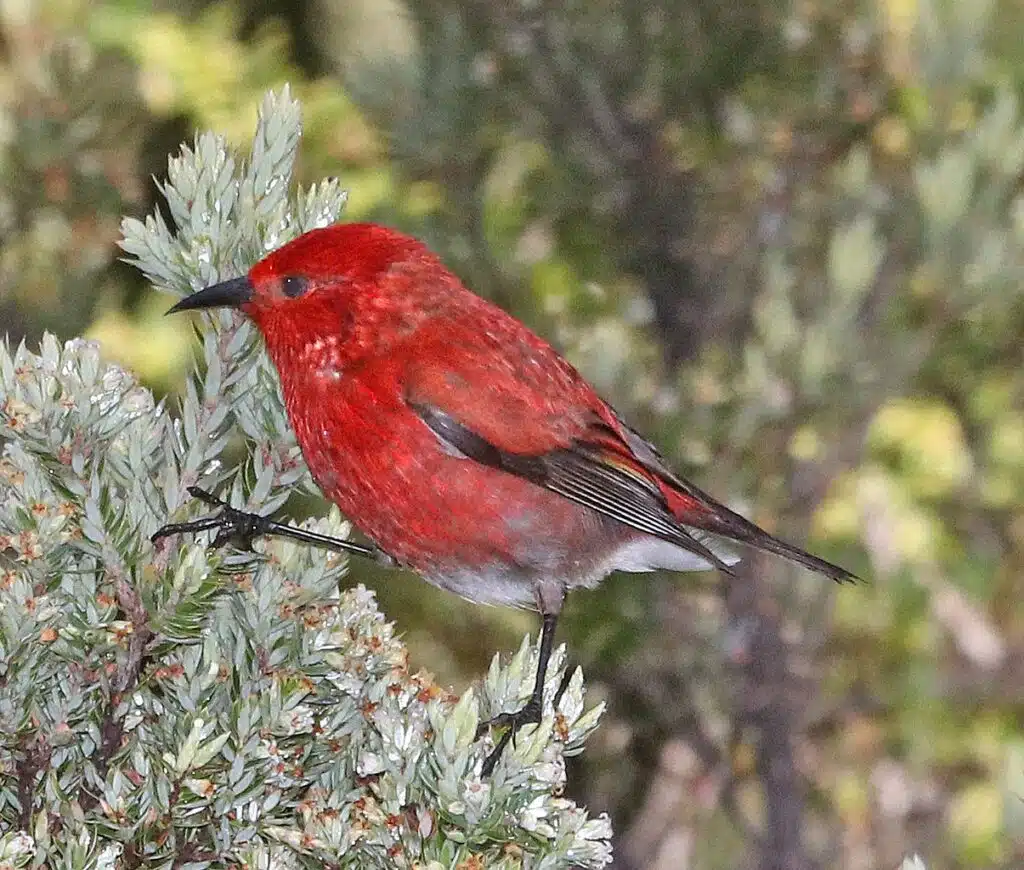
A remote Hawaiian species, ‘Apapane birds (Himatione sanguinea) show vivid red coloring.
Much of the lives of these red birds are spent up on trees. They jump and fly from one branch to another for food, mostly at the canopy level.
The red coloring is specific to the head and underbelly of this species. Its base wings are also red while the tips of its wings are mostly black.
White plumage is a further characteristic of these birds but to a small extent. Only the ventral tail and the lower belly are white.
An important nectarivore, ‘Apapane birds are considered a species that help pollination on the islands.
Juveniles of the species have gray and brown coloring and may not resemble adult males.
Distribution – Hawaii
Red plumage nuance – bright red
13. ʻIʻiwi
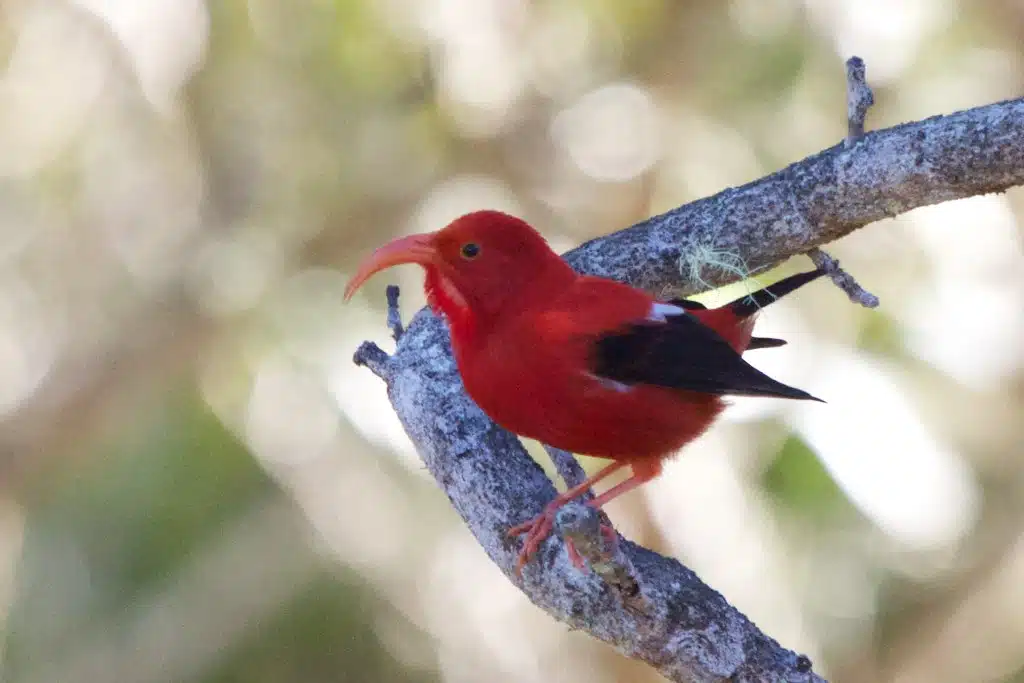
‘I’iwi (Drepanis coccinea) is another highly common red bird of Hawaii. Unlike ‘Apapane, ‘I’iwi birds also have red legs and beaks, with an orange undertone.
These birds are mostly red. Their red plumage is vivid and only contrasted by the black wings with a few white feathers at the base.
While only found in Hawaii, these birds with curved beaks are still found in high numbers.
By some estimates, they might still be around half a million ‘I’iwi birds left in Hawaii.
Most of their lives are spent in the moist high elevation forests of the islands.
Distribution – Hawaii
Red plumage nuance – bright red
14. American Flamingo
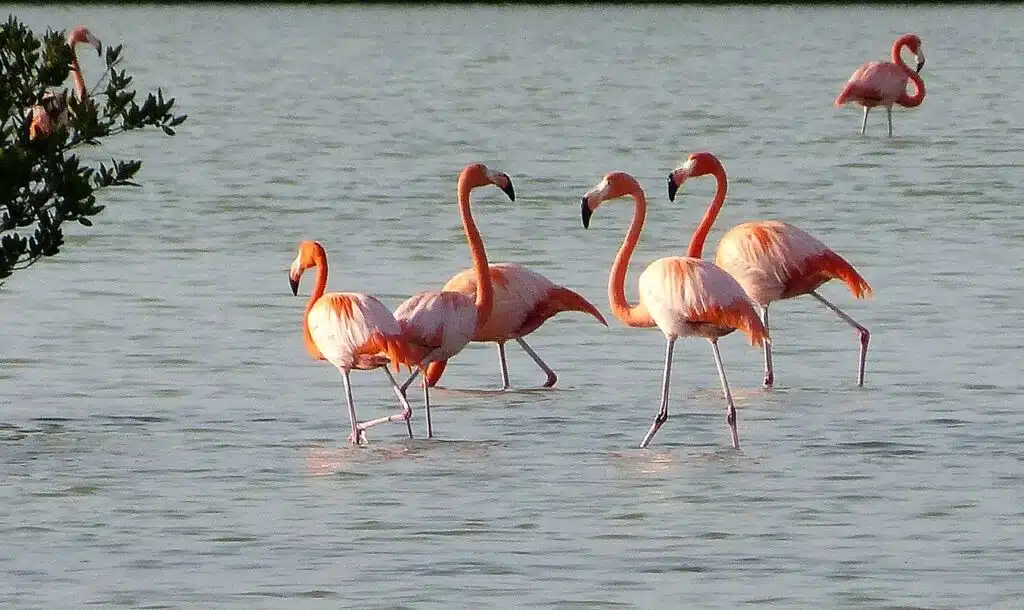
The American Flamingo (Phoenicopterus ruber) is one of the largest red birds in The Americas.
Its red nuance is pale or pink-red and never vivid red. These birds with long necks have white, red, and black beaks.
Various nuances of pink-red are seen across its head, belly, and neck. Unlike other red birds, American Flamingos have brighter wings compared to the rest of the body.
The American Flamingo is a species that prefers warm tropical climates. Its breeding season is when the species can easily be spotted in Central and North America.
Occasionally spotted in mainland US territories, The American Flamingo is mainly a species of Southern Florida.
Breeding rates are reduced for the species as the female American Flamingo only lays one large egg.
Distribution – tropical regions of The Americas
Red plumage nuance – pink-red
15. Northern Red Bishop
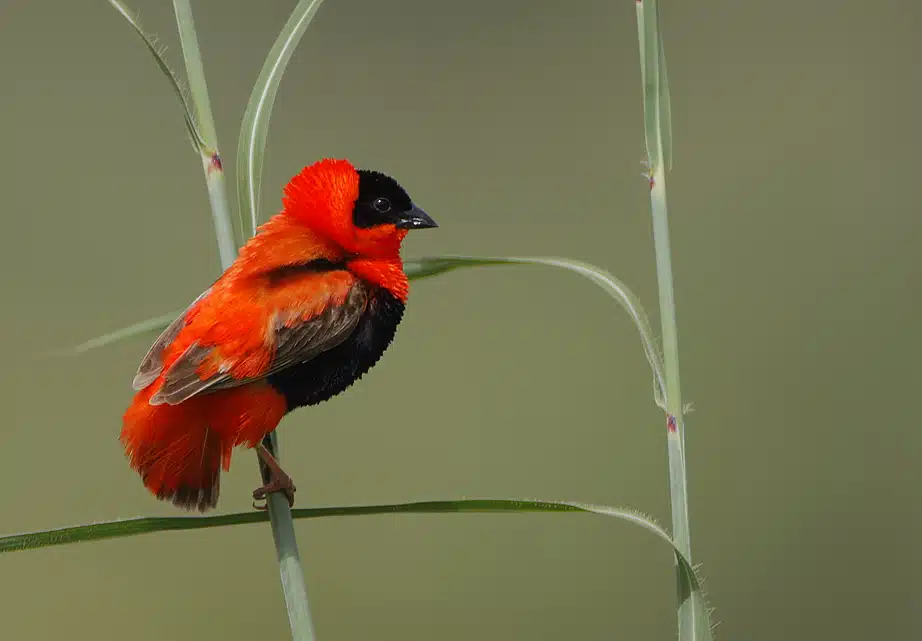
Northern Red Bishops (Euplectes franciscanus) are colorful red birds with short tails native to regions of Africa.
An introduced species to The United States, Northern Red Bishops are still in their incipient populations across California.
An orange and black species, this bird turns red and black going into its breeding season.
Its head and wings are red while the face and the underbelly of the species are black.
Living next to marshes or water, Northern Red Bishops are usually easy to spot in their communal living.
Flocks of Northern Red Bishops count anywhere between 30-40 birds to 300-400 birds.
They are also very loud together due to their high-pitched calls.
Distribution – sub-Saharan Africa, California, US Virgin Islands
Red plumage nuance – dark red
16. Crimson-collared Grosbeak
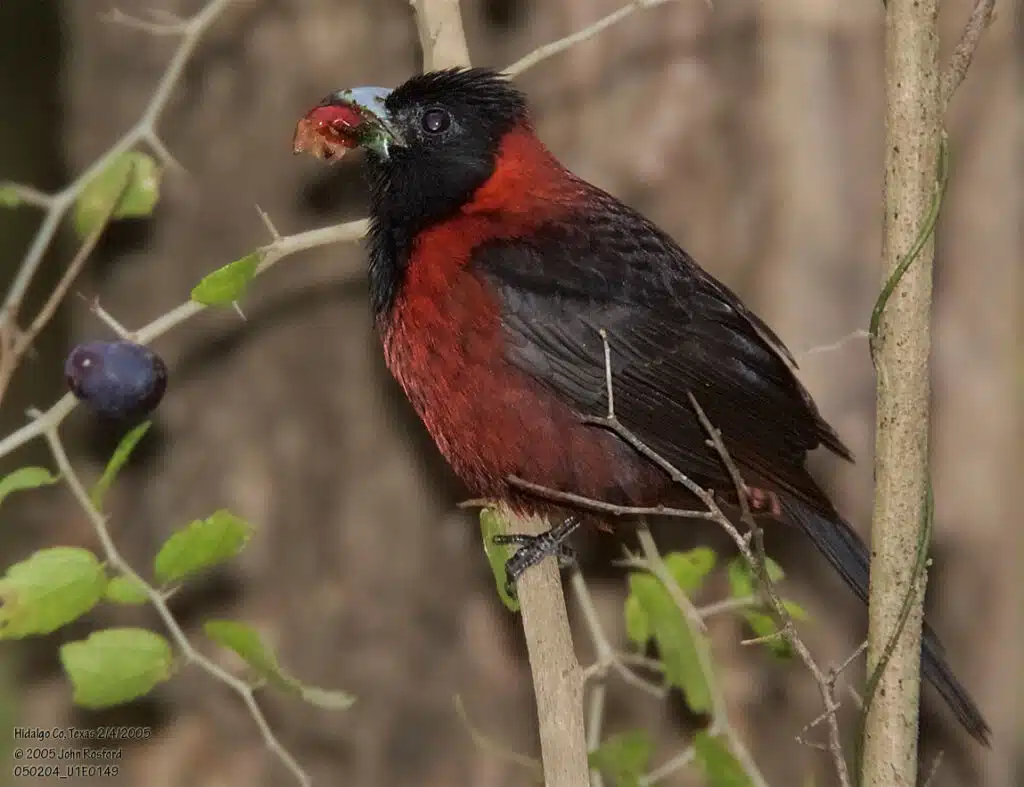
A species of The Americas, Crimson-collared Grosbeaks (Rhodothraupis celaeno) are named after their crimson red color.
This is a type of darker red, often closer to rust red than vivid red.
Its head is mostly black with a small black crest and a black beak.
The shoulders and the underbelly are also crimson red. Its black wings show red nuances as well.
Females of the species show a combination of olive, gray, and black plumage.
Both males and females share at least a few physical traits, such as the color of the face. Male and female Crimson-collared Grosbeaks have black faces.
Distribution – Southern Texas, East Mexico
Red plumage nuance – crimson red
17. Flame-colored Tanager
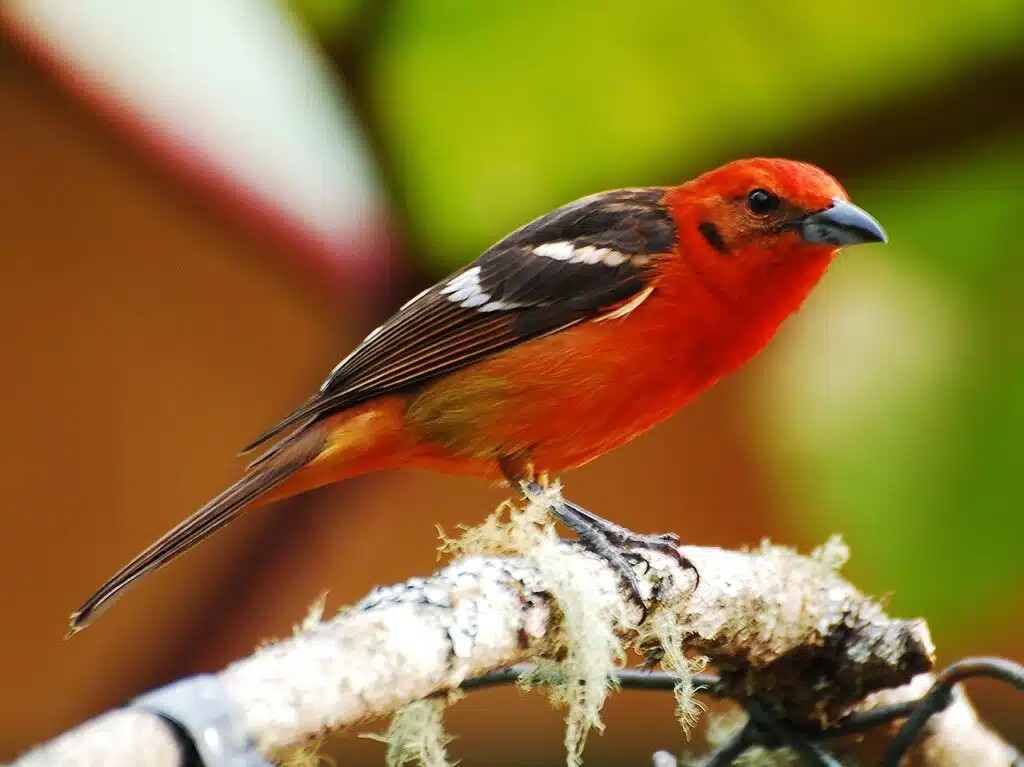
Red nuances are specific to the Flame-colored Tanager (Piranga bidentata). Males of this species also have orange and yellow plumage, as its name implies.
Its head is mostly red, with an orange undertone while its lower underbelly is yellow.
Birds of this species have gray-brown wings and a dark beak.
Female Flame-colored Tanagers have an olive nuance with black wings and have a few orange-red feathers, mainly in the front of the crown.
Females and males only share the dark nuance of the wings which have a few contrasting white spots.
Distribution – Arizona, Texas, Central America
Red plumage nuance – red-orange
18. Red Avadavat
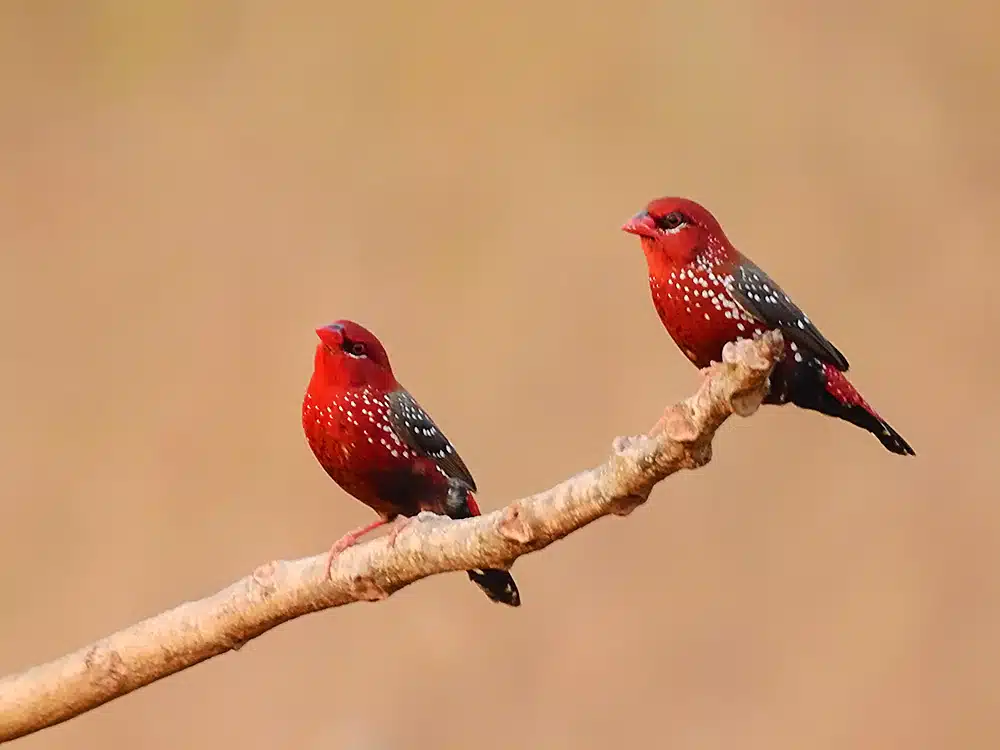
Red birds with red beaks might not be easy to spot. This is the color pattern of the male Red Avadavat (Amandava amandava).
Males birds have a bright red appearance with a pale red beak. Their heads are mostly dark red with black areas around the eyes.
The underbelly is bright red and shows white spots, as do the wings.
Females have a mostly yellow appearance with gray wings and a similar pale red beak and a black mask similar to males.
Males of this species have a green dominant appearance in their non-breeding plumage. The contrasting appearance of these birds has been the reason for their introduction around the world.
Distribution – India, Pakistan, Thailand, Vietnam
Red plumage nuance – deep red
19. Chestnut Munia
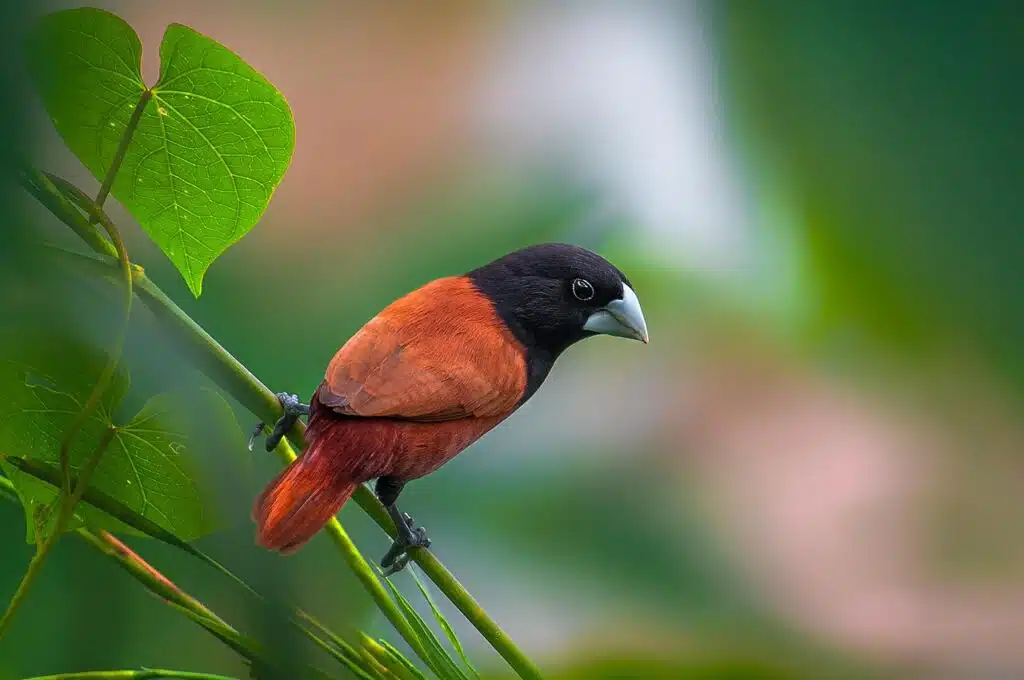
A chestnut-red nuance dominates the appearance of The Chestnut Munia (Lonchura atricapilla).
A contrasting appearance and plumage without overlays are specific to these birds. Their heads are black while their beaks are white.
Chestnut-red bellies and wings dominate the appearance of these birds. The same chestnut-red color is also seen on the back of these birds.
The atypical chestnut color of The Chestnut Munia is one of the reasons for the introduction of the species in Central and North America.
The species is believed to be a potential risk for crops due to its excessive feeding habits. Chestnut Munias feed on grains.
Distribution – Southeast Asia
Red plumage nuance – chestnut-red
20. Red Warbler
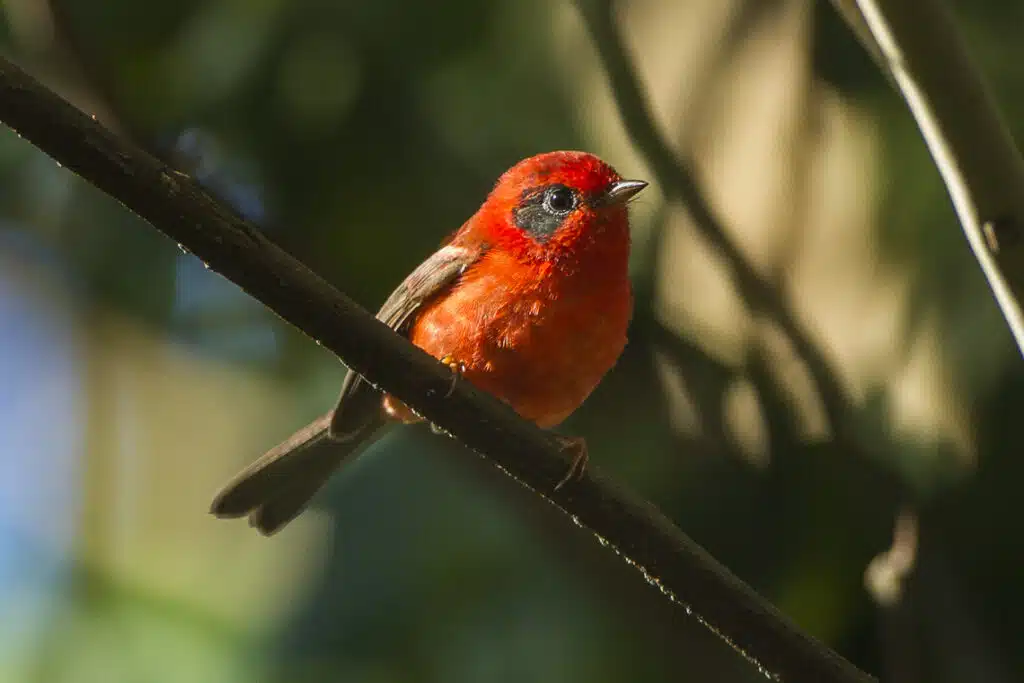
Red Warblers (Cardellina rubra) have different shades of pink and red, depending on their age. Red plumage is characteristic of adults while young birds are mostly pink or pink-red.
Adult Red Warblers also have dark rims around the eyes while young birds may have brighter or even white rims around the eyes.
Red adults also show red and black wings, with the red sections being closer to the base.
A species mostly seen in Mexico, Red Warblers are highly active from February as they start breeding.
This species has been spotted in the Southern parts of Texas in the past but in small numbers.
Most of its range includes the higher elevation grounds in the Southern parts of Mexico between the Pacific and The Gulf of Mexico.
Distribution – South Mexico
Red plumage nuance – bright red
21. Scarlet Ibis
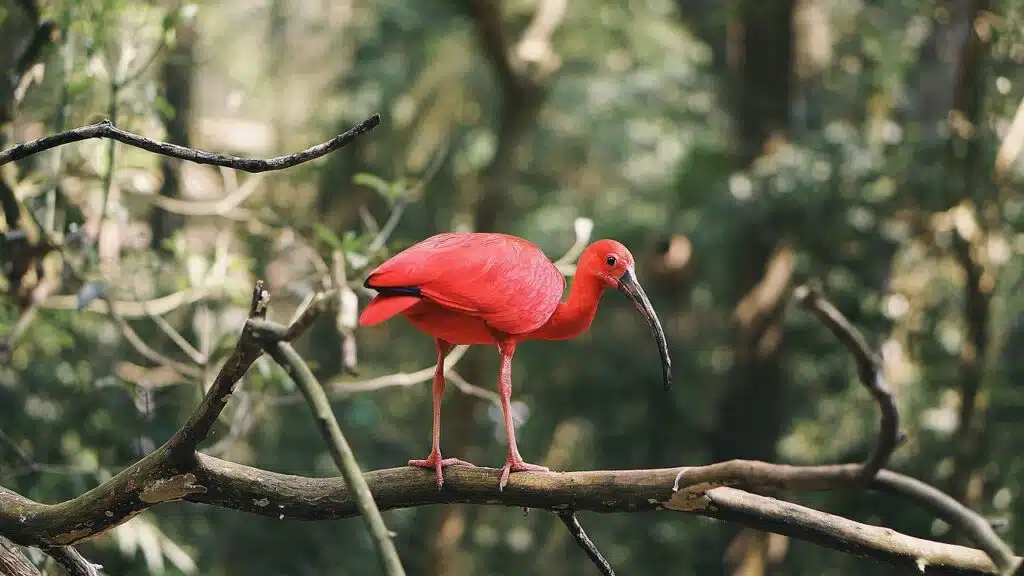
Scarlet Ibises (Eudocimus ruber) are birds of South American shores. Present along the Atlantic Coast, these birds are specialized in mudflats of the shores, spaces where they look for food with their long beaks.
Named after their scarlet red color, these birds have a bright red appearance. The scarlet color itself is a combination of red and orange.
Scarlet covers its head belly, and wings. Its long beak is mostly black.
As one of the most important shoreline species of Brazil, Scarlet Ibis and its morphs have been introduced in North America.
Small pink variants are spotted around Miami on occasion. This scarlet morph is also known to breed with its white morph.
Distribution – The Atlantic coastline of Northeastern South America
Red plumage nuance – scarlet red
22. Crimson Rosella
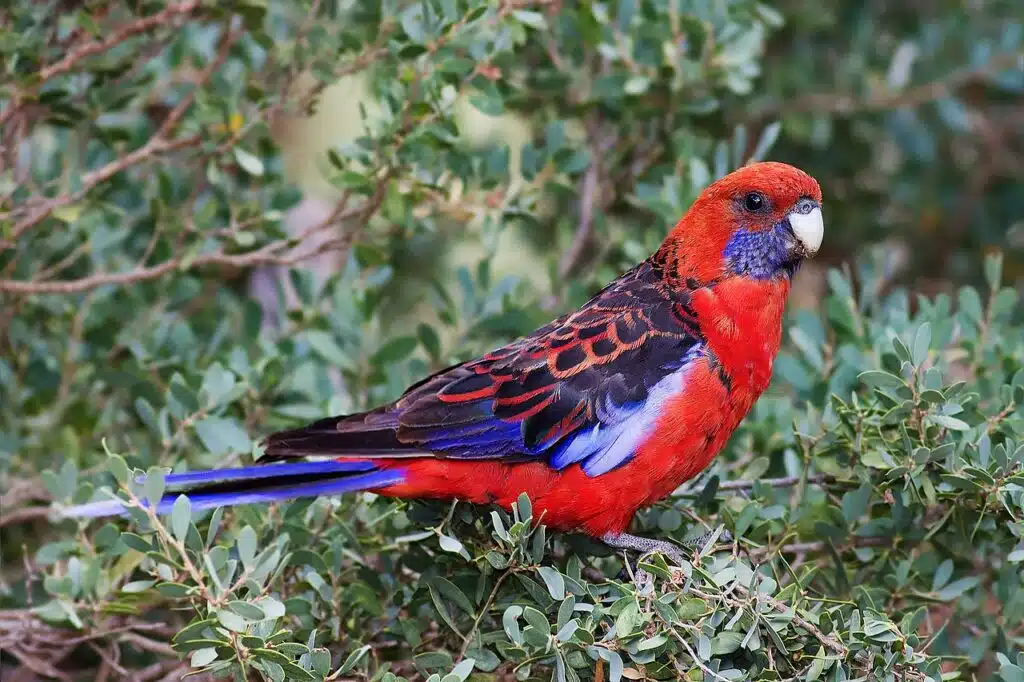
Known for their bright red color, Crimson Rosella (Platycercus elegans) is one of Australia’s species of parrots. These birds have a crimson red dominant color, which makes them stand out immediately.
Birds of this genus are seen in 7 subspecies, most being red.
The red variation of the parrot has a red head and underbelly with a blue neck. Black and blue wings are specific to these parrots while their tails are blue.
Mostly spotted in pairs or in very small groups, these birds are known as sedentary.
They are monogamous in their breeding season and are known to differentiate between the different parrots of their species by smell.
Distribution – East and Southeast Australia
Red plumage nuance – crimson red
23. Australian King-Parrot
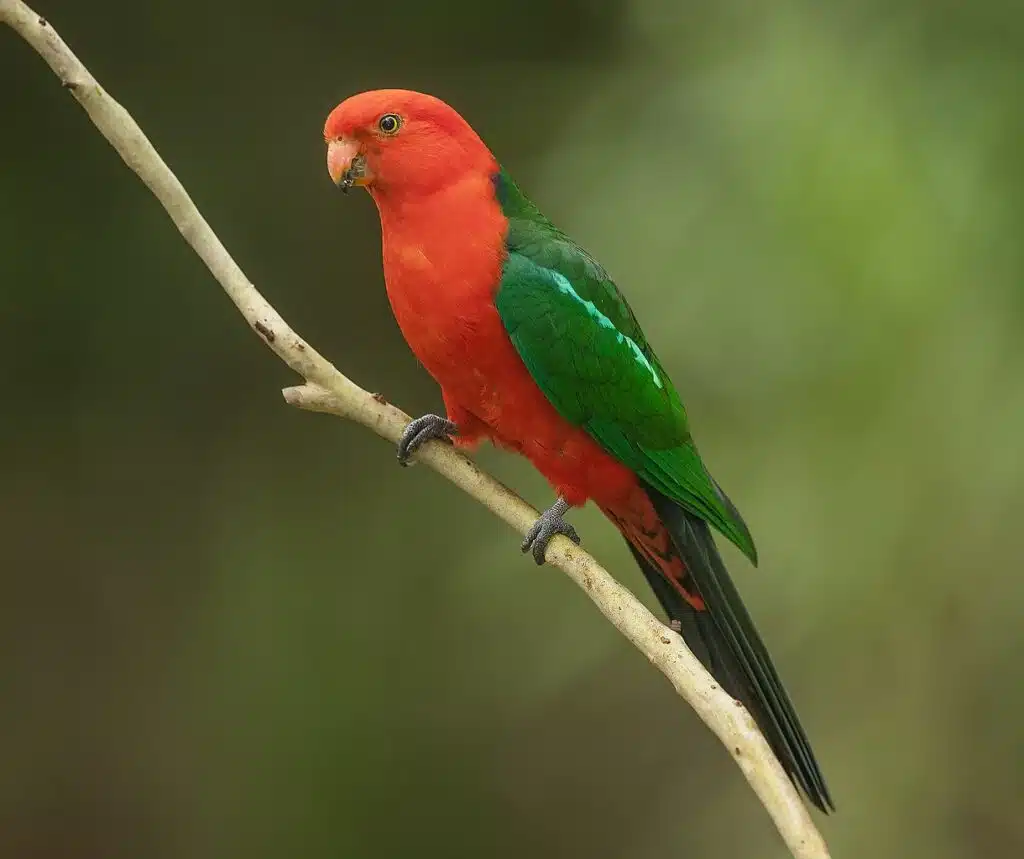
Much like the Crimson Rosella, Australian King-Parrots (Alisterus scapularis) are also dominated by red nuances.
However, the red nuance of these parrots is different, closer to orange rather than a darker crimson nuance.
A red head and belly are spotted on these parrots while their backs and wings are dominated by green nuances.
Some plumage differences also exist between males and females. If males have a red head, females have a green head.
Juveniles are dominated by bright green heads and wings and bright orange-red underbellies.
Australian King-Parrots share much of their territory with other parrots of the continent. They may sometimes be spotted with Crimson Rosellas, typically in small groups.
Distribution – Eastern Australia
Red plumage nuance – bright red
24. Crimson-backed Tanager
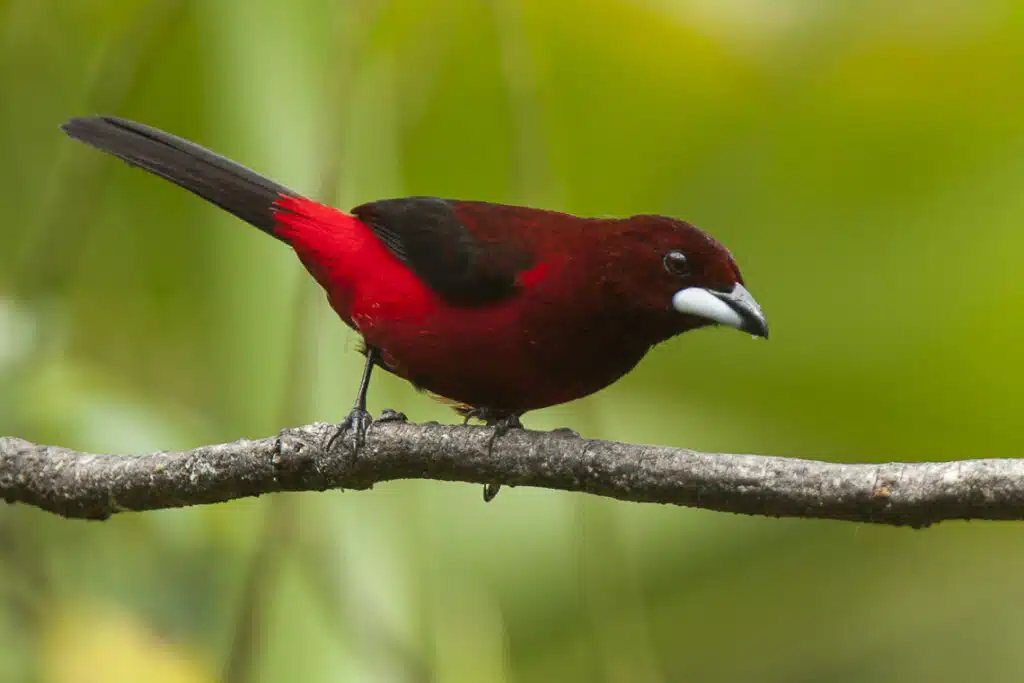
Reaching a size of up to 7.1 inches, Crimson-backed Tanagers (Ramphocelus dimidiatus) are one of the common crimson birds of South America.
This is a species with clear color separation between the sexes.
Only male Crimson-backed Tanagers have crimson bellies, wings, and heads. Their beaks are white while their tails are black.
Females are brighter and dominated by tan-to-brown nuances. Females have brown heads and bright brown underbellies. A bright beak is the only coloring similarity to males.
Females also have long tails, similar to males. However, females have brown tails and not black tails.
Inhabiting tropical forests in its native range in high numbers, this species is mostly seen on its own or in very small groups.
Distribution – Colombia, Venezuela, Panama
Red plumage nuance – crimson red
25. Red-throated Ant-Tanager
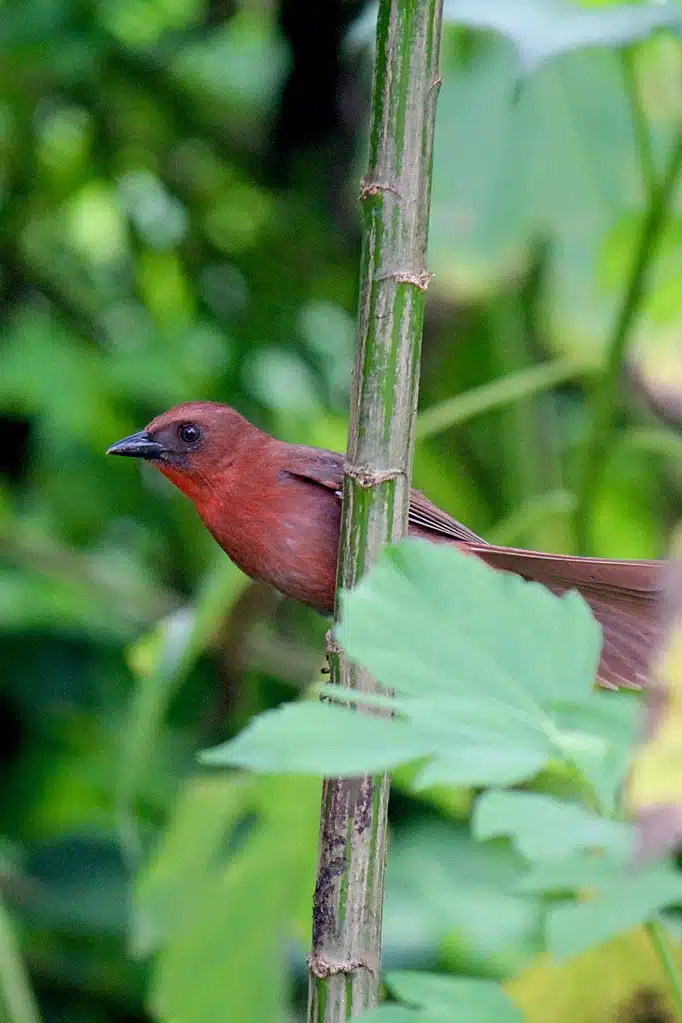
A red color of a bright nuance dominates the plumage of male Red-throated Ant-Tanagers (Habia fuscicauda).
Males show a red head with a black face mask, a red underbelly, and red wings.
Females have no red plumage and are dominated by yellow-olive nuances, with duller coloring.
These birds live in tropical areas of The Americas. They often move to the lowlands for food.
Even if they can eat other insects and even fruit, Red-throated Ant-Tanager prefers ant colonies as they are easier to feed on.
In this habitat, they are among the few ant-eating species which also means have access to more army ants for themselves.
They may also look for food at various higher altitudes of up to 2.000 feet.
Distribution – Mexico, Venezuela, Colombia
Red plumage nuance – bright red
26. Red-billed Firefinch
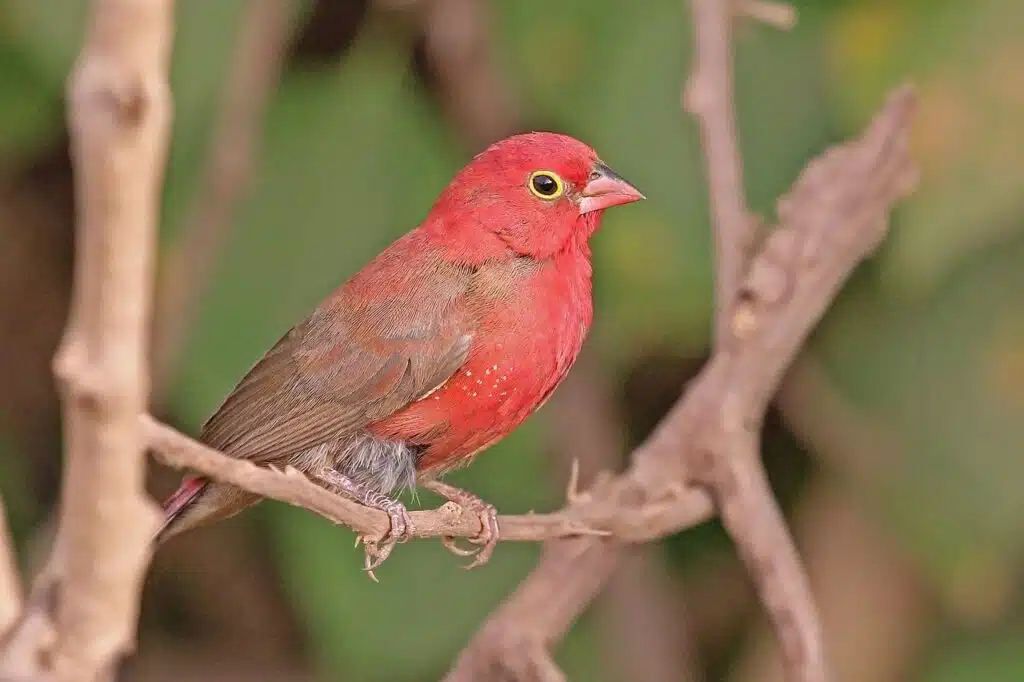
A vivid red nuance known as scarlet red is specific to the Red-billed Firefinch (Lagonosticta senegala).
These are some of the smaller red birds in the world, often reaching a maximum size of 3.9 inches.
The name of the species is derived from the pale red beak color of males.
Red plumage dominates the appearance of male Red-billed Firefinches. These birds have a red head, a red belly, and red-black wings.
Females are dull gray with gray-brown bellies that show contrasting white dots.
Red sections are still seen in females but to a lesser extent. They show red patches at the sides of the head and on the tail.
A species that build small nests to lay multiple white eggs in, these birds are mostly preoccupied with finding food such as seeds.
Distribution – sub-Saharan Africa
Red plumage nuance – scarlet red
27. Andean Cock-of-the-Rock
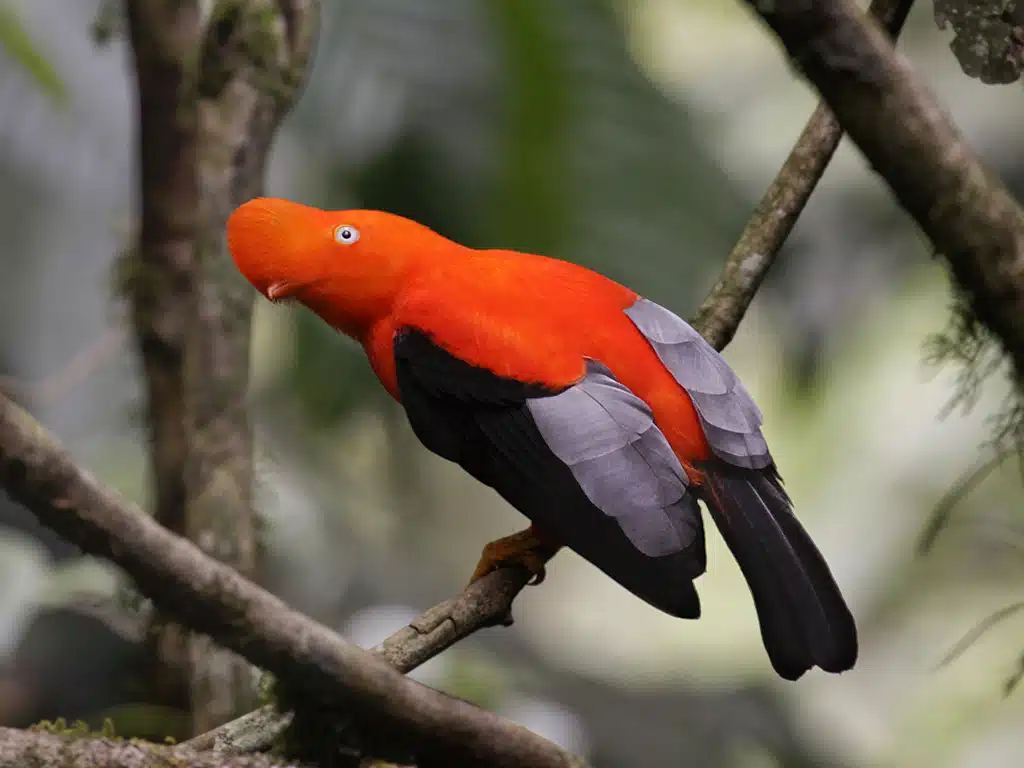
This species (Rupicola peruvianus) is named after its South American Andean range. It lives in tropical forests where it can feed on fruits and insects.
The atypical appearance of males is based on their disc-like crest shape.
Male Andean Cock-of-the-Rock birds are either orange and black or red and black, depending on the season.
The time when they are red is marked by a bright red nuance of their head, crest, and bellies. They also have red plumage on the upper back.
Black and gray colors are combined on its wings.
Females have a brown-red nuance with dark red wings and tails.
Distribution – Colombia, Ecuador, Peru, Bolivia
Red plumage nuance – bright red
28. Brazilian Tanager
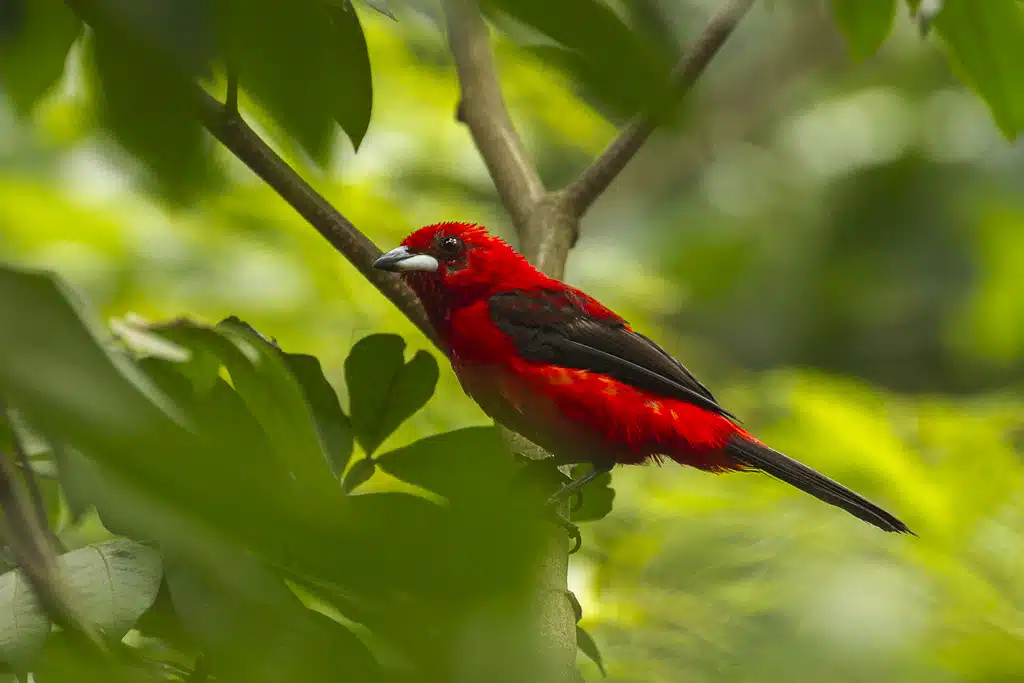
Coastal scrubs of Brazil are among the favorite forested habitats of The Brazilian Tanager (Ramphocelus bresilius).
This is one of the most common species of the state with vivid red plumage. Crimson red bellies and heads are specific to male Brazilian Tanagers.
These birds have a red and white beak and long black tails with additional black feathers on the wings.
Females are mostly brown, with brown wings and orange-red underbellies. Long tails are also seen on females but of a brown color and not a black color as on males.
Much of the lives of these birds are spent looking for seeds and fruit.
Females lay a small cluster of green-blue eggs in the breeding season in a built cup-like nest.
Distribution – coastal Brazil
Red plumage nuance – crimson red
29. Crimson Finch
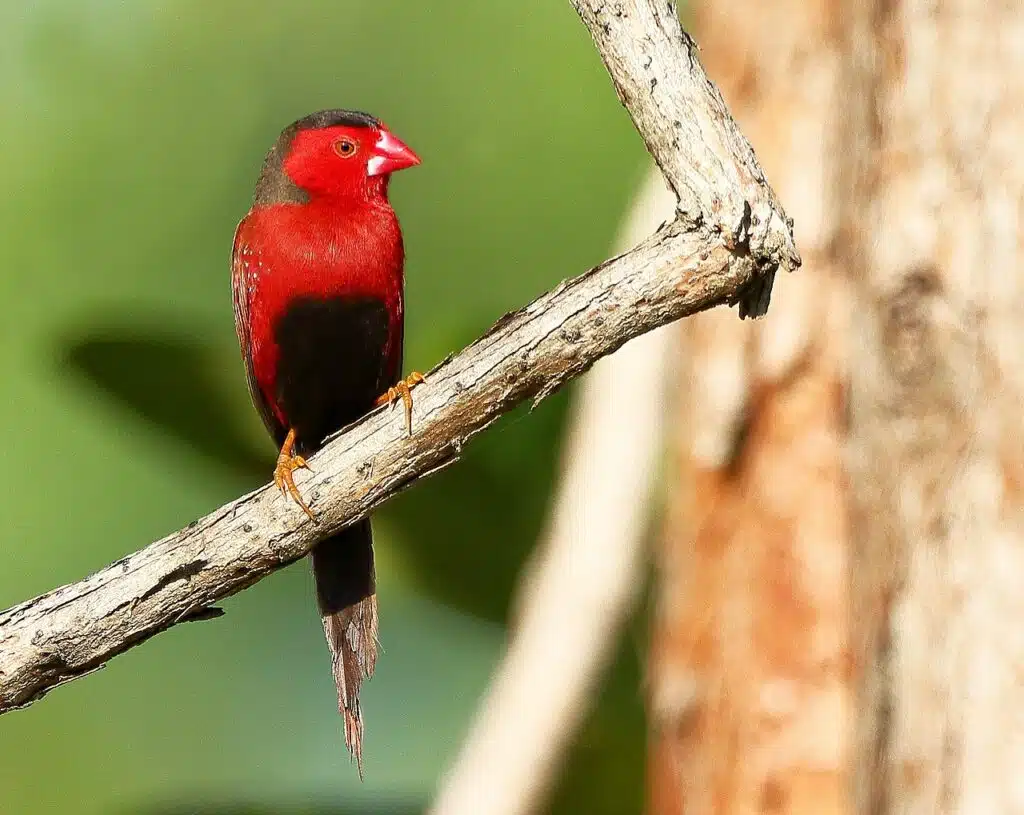
Crimson red coloring is also specific to Crimson Finches (Neochmia phaeton). These birds have small differences between the sexes which include coloring.
Males are heavier and have long tails but they also show more red nuances across their bodies.
They have a crimson red head and underbelly with dark red wings and a black crest and upper back. Their long tails are also crimson red.
Females only show red coloring on the face and bill, and partly on the wings. Smaller females have pale gray underbellies.
Some of the preferred habitats of the species include tropical forests and areas with pandanus trees.
Much of the range of this species is limited to Northern Australia. Their coloring also makes them a sought-after species in captivity.
Aggressive male Crimson Finches may need very large enclosures.
Distribution – Australia, New Guinea
Red plumage nuance – crimson red
30. Northern Carmine Bee-Eater
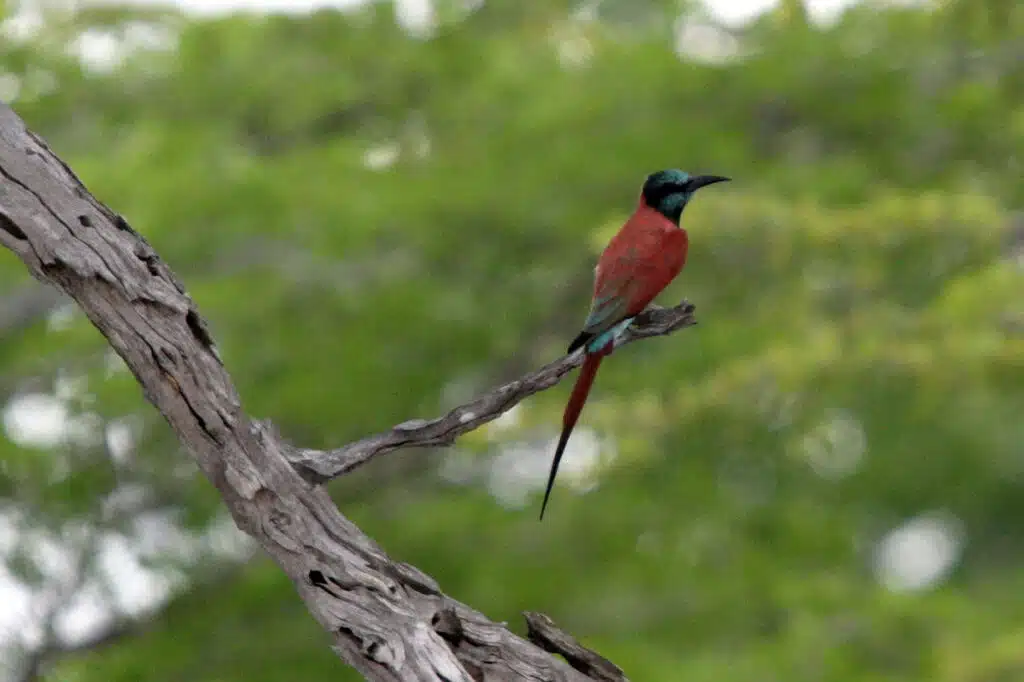
A mostly red appearance is specific to The Northern Carmine Bee-Eater (Merops nubicus).
The carmine nuance of the species means its red plumage has slight purple nuance.
Its underbelly and wings have a carmine-red nuance while its head has an iridescent green-blue nuance.
A black band runs from its curved black beak to the back of its head. Its tails are also black.
An African native, this species is found in very high numbers in tropical regions of North Africa.
They live next to water sources where they often share their habitat with large animals where they can rest on.
These types of birds are known to breed in flocks, which means they are easily spotted. They easily heard their rasp-like calls.
Distribution – sub-Saharan Africa
Red plumage nuance – carmine-red